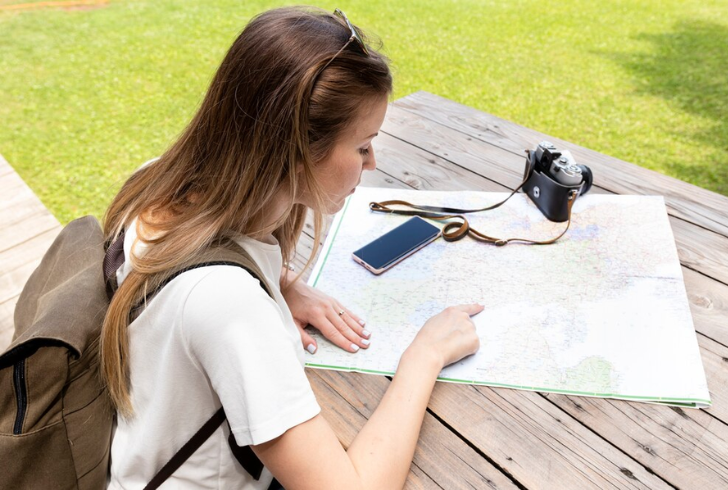Ever dreamt of escaping the hustle and bustle of everyday life for an immersive adventure in nature? Backpacking offers the perfect way to disconnect from the digital world and reconnect with yourself and the breathtaking beauty of the wilderness. But for first-time backpackers, the prospect of a multi-day hike can feel daunting. This guide will equip you with the essential knowledge on how to backpack, transforming that daunting feeling into an exciting anticipation for your upcoming adventure.
Why Should You Go Backpacking?

Freepik | rawpixel.com | Backpacking provides a deeper, immersive nature experience unmatched by day hiking.
Backpacking offers a unique and immersive experience, allowing you to connect with nature in a way that day hiking can't match. When you backpack, you can enjoy the serenity of sunrises and sunsets, encounter wildlife in their natural habitat, and explore remote areas that few people get to see. The absence of modern distractions lets you unplug and focus on the present, leading to profound personal insights and increased self-confidence.
Backpacking Gear for Beginners
Essential Gear Checklist
Before you set out, it's crucial to have the right equipment. Here's a breakdown of the essential gear you'll need:
Backpacking Pack: Choose a pack with a capacity between 40-75 liters. Ensure it fits your torso length and consider women-specific packs if applicable.
Backpacking Tent: Opt for a lightweight tent under 4 lbs/1.8 kg with a waterproof fly.
Sleeping Bag: A three-season sleeping bag rated between 39°F/4°C and 15°F/-9°C is ideal.
Sleeping Pad: Choose an inflatable pad with an R-value of at least 2.5 for warmth and comfort.
Water Filter or Purifier: Avoid drinking untreated water; use a reliable filtration system.
Backpacking Stove: A compact single-burner stove is versatile and efficient.
Clothing: Pack lightweight, quick-drying clothes made of nylon, polyester, or wool. Avoid cotton.
Hiking Boots: Invest in comfortable, supportive hiking boots to prevent blisters.
The Ten Essentials: Always carry emergency supplies including a first aid kit, headlamp, knife, navigation tools, and a communication device.
Saving on Gear
Backpacking gear can be expensive, but there are ways to save. Consider renting gear, borrowing from friends, or buying used equipment. Look for sales and prioritize lightweight and compact items.
Essential Tips on How to Backpack Safely
Navigation
Mastering navigation is crucial for safe backpacking. Always carry paper maps and a compass, and consider using GPS apps. Practice using these tools on day hikes before your backpacking trip.
Bear and Wildlife Safety
Encountering wildlife is part of the backpacking experience. Hike in groups, make noise, and keep dogs leashed to avoid bear encounters. Store food securely and never feed animals. Carry bear spray and know how to use it.
Leave No Trace Principles
Minimize your impact on the environment by following the seven principles of Leave No Trace. This includes packing out all trash, respecting wildlife, and camping on durable surfaces.
Hygiene
Maintaining hygiene on the trail is essential to avoid illness. Use hand sanitizer, pack out used toilet paper, and take sponge baths with a quick-dry towel. Women should also be prepared with menstrual supplies.
How to Plan a Backpacking Trip
Choosing a Trail - Select a trail that matches your fitness level and experience. For beginners, look for easy to moderate trails with relatively flat terrain and established campsites.
Permits and Local Rules - Check if the area you plan to visit requires permits and familiarize yourself with local regulations regarding campfires, drones, dogs, and group sizes.
Transportation and Gear Check - Plan your transportation, whether it's driving to the trailhead or arranging a shuttle for one-way hikes. Ensure you have all the necessary gear and that it is in good working order. Share gear with your hiking partners to save space and weight.
Picking Hiking Partners - Choose your hiking partners carefully. It’s best to go with friends or join a hiking club. Make sure your group has a mix of skills and compatible personalities.
Step-by-Step Beginner Backpacking Plan

Freepik | Opt for a short, easy trail for your first overnight trip to adjust to carrying a heavier pack and wilderness camping.
Step 1: Start with Day Hikes
Begin with day hikes to build your fitness and familiarize yourself with the gear. Practice navigation and other essential skills.
Step 2: Plan an Overnight Trip
Choose a short, easy trail for your first overnight trip. This will help you get used to carrying a heavier pack and camping in the wilderness.
Step 3: Gradually Increase Difficulty
Gradually tackle longer and more challenging hikes. This will build your confidence and improve your fitness and skills.
Step 4: Join a Group Trip
Consider joining a group trip organized by a hiking club or outdoor store. This provides support and an opportunity to learn from more experienced backpackers.
Step 5: Plan Your Own Multi-Day Trip
Once you’re comfortable, plan and execute your own multi-day backpacking trip. This will be a culmination of your training and preparation, giving you the freedom to explore new areas and experience the wilderness on your terms.
Backpacking can be a transformative experience, offering a deep connection to nature and a chance to test your limits. Learning how to backpack with the right preparation, gear, and mindset will allow you to embark on your first backpacking trip with confidence. Happy trails!







